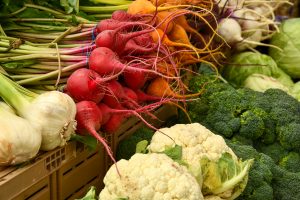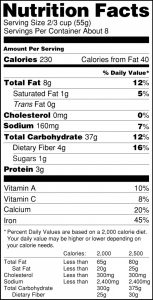Ignorance is Bliss: Consumer Thoughts on Food Labels
Casey Carroll

Chocolate chip cookies, potato chips, donuts, pizza, French fries, ice cream, nachos…Is your mouth watering yet? Growing up, I loved all things processed. Any junk food I could get my hands on was a salty, fatty, sugary dream that I could not wait to sink my teeth into. I did not care about what harmful chemicals were going into my body or that I was receiving little to no nourishment. Inevitably, the day came when I became alarmingly aware of what was in my food. After watching endless food documentaries in my high school classes and with my older sisters, I could no longer ignore the nutritional facts and labels found on the food I was eating. Seeing graphs of how much sugar was in each food versus how much someone should consume in a day was the last straw. No one should consume over four times the recommended daily value (Gunnars, 2021). I was forced to sit and truly think about where my food was coming from and what I was doing to my body. My own experience led me to consider the history of food labeling and how people decide whether they will look at a food label. If food labeling is required, then why isn’t every consumer concerned with and checking what they are eating?
The history of food labeling is alarming. Food labeling began shortly after President Zachary Taylor died from consuming contaminated fruits and milk at a picnic (The University Of Texas, 2021). Due to the president’s death and the rise in foodborne illness outbreaks in the 1850s, President Abraham Lincoln created the United States Department of Agriculture (USDA). At this time, the USDA created strict food handling and processing guidelines. However, it was not until 1966 that the USDA mandated that ingredients must be listed for prepared products so consumers would know exactly what they were eating. Before the 1960s, most Americans prepared the majority of their meals at home and knew what was going into their food. In 1990, the USDA finally mandated that every food company be required to make consistent claims and include a standardized nutrition facts panel on all sold food products (The University Of Texas, 2021). With this mandate, many companies began putting labels on their food such as “low fat” and “heart-healthy” which were then also regulated. All in all, the food industry added mandatory food labels to keep people safe and healthy. So, why does that not seem like the case anymore?
The newest regulations surrounding food—including food labels—are seemingly intended to help consumers learn about what they are eating, but according to food journalist Michael Pollan, people should avoid looking at health claims and nutritional values (On the Media, 2008). He states that truly healthy foods, like fruits and vegetables, are silent. He believes that people need to go back to their roots and eat fresh, unprocessed foods instead of foods derived from generations of dietary trial and error to figure out what people like (On the Media, 2008). The nutrition facts on food products have little to do with how good something is for you. Food and nutrition trends come in and out of style so often and there is little evidence to back most of it up. To assure healthy eating, Pollan encourages people to take back control of their diets and stray away from processed foods with nutritional labels and go for fresher, more “silent” options. By buying products that do not contain food labels, consumers will be assured that they are eating right.
Ever since I was able to purchase my own food and drinks, I have become much more preoccupied with what is in my food. Every week, I sit down, plan out what I am going to eat that week, write a grocery list, and go to the store to buy ingredients. Thinking about how I grocery shop and how food labels and nutritional facts dictate what I buy made me want to dig deeper into how people shop and whether food labeling and nutritional facts affect purchasing decisions and pose questions such as: Do consumers look at the labels and nutritional facts on their food? Do labels and nutritional facts determine whether or not consumers buy a food item? What is the most important thing for consumers when they purchase a food item? Which food brands are people loyal to and why? I interviewed multiple people in different age groups to get an insight into how they think and feel about the food they are buying. I received a wide range of responses from the individuals surveyed.
Julia Williams, a 21-year-old college senior at Indiana University Bloomington, commented that she buys the same food items every time she goes to the grocery store. She is a picky eater and does not look at food labels. Williams believes looking at food labels and nutritional facts would probably deter her from buying products and then she would be left with nothing to eat. Williams is not alone. According to the TIME Magazine article “Study: Why People Don’t Read Nutrition Labels,” the majority of people that say they look at nutrition labels do not (Melnick, 2011). Using eye-tracking software, they found that only 37% of people looked at nutrition labels. The study proves that people tend to avoid looking at food labels and would rather not see what is in their food. The study also shows that food labels are not helping people make healthy purchasing decisions. Consumers need to care and want to know what is in their food to look at these food labels.

Relatedly Aimee Snoke, a 50-year-old entrepreneur, explains how she only recently began looking at and analyzing food labels and nutrition facts. She discusses how reading these labels did not become commonplace until a couple of years ago. Now that she has heard horror stories about what is in her food, she has started looking. Snoke became aware of these issues by listening to friends, reading articles, and realizing it is much harder to stay fit as she gets older. She believes you need to look at what goes into your body and to know what you’re eating. When you start feeling and looking better, it becomes a habit.
“I have started looking more closely at food labels over the past few years just as awareness grows with the additives and ingredients that many companies add,” Snoke says. “I will always look at the label if it is a product I am unfamiliar with, or I am comparing two brands of the same thing. I’ll go for the product with fewer additives, fewer calories, and whichever looks healthier.” Snoke mostly considers the sugars and oils used. If either is the first on the ingredient list, she does not buy the product. She also states that she is conscious of ingredients and nutritional value unless she is buying something for a family recipe. She will buy those ingredients no matter what. Along with the ingredients, the price also has a say in what she buys. Snoke also wanted to mention that she recently downloaded an app that logs all the values of everything she eats, but that it became very time-consuming. She trusts that if she is eating natural or organic meat and fresh produce, that she is eating well. Snoke’s dedication to looking at ingredient lists made me want to learn more about the types of ingredients to look for when discovering what you are eating.

Many people besides Snoke are concerned with reading food labels. To help with the issue, journalist Emma Christensen wrote an article to help people make sense of food labels (Christensen, 2019). She knows people can get confused when there seems to be a new “bad for you” ingredient every day. First and foremost, she says to look at the ingredients listed first. The first ingredients listed are what are in the product the most. Consumers should make sure they are okay with the first listed ingredients before buying a product (Christensen, 2019). Next, Christensen recommends looking at any ingredients ending in “-ose” because they are different types of sugars. People should also look for any and all fats and oils listed. Lastly, she advises to put down any food product that lists ingredients that cannot be pronounced. They are probably not naturally derived and may not be good for people (Christensen, 2019). Overall, she believes people should be aware of what they are putting into their bodies, and if they think an ingredient does not sound right, move on!
Cally Arn, a 28-year-old videographer, was the person I spoke with who was the most aware of what she was putting into her body. She is very interested in learning about health, wellness, and hormones for her personal knowledge and lifestyle. Arn believes organic fruits and vegetables are the true keys to being healthy. She is also very aware of reading labels. “I look at labels because the government has allowed big food corporations to put indigestible and poisonous—and even cancer-causing—gums, preservatives, chemicals, and dyes in so many common and popular foods it’s horrifying,” Arn says. “Labels help me find healthier alternatives and have stopped me from buying certain foods.” Additionally, nutrient-dense food incentivizes her to buy and try new foods as long as the sugar content is low, and she is happy with the ingredient list.
Arn seems to be on to something. There is much information about how labels and nutritional facts are misleading to consumers. Although there are people like Snoke and Arn that are vigilant about looking at ingredients and nutritional values, companies have made it so consumers are ignorant about their health and what they are putting into their bodies. Consumers cannot be held fully accountable for the products they buy. Some people may think they are ultra-aware of what they are purchasing, but labels have been misleading consumers for a long time. This is what food companies want.
According to A Greener World, food companies use positive-sounding terms and claims about issues such as the environment and how farm animals are treated (A Greener World, 2021). Many of these label claims are legally defined, but there is little to no policing and regulation about who and what can use them. In most cases, it was found that farmers or food producers simply had to sign a paper to state they are following guidelines. No one is checking in and making sure food companies are following these guidelines. This is a serious form of information asymmetry, which is a situation where one party—in this case, food companies—knows more about the foods they are selling than the consumers. Consumers believe they are buying ethically, but in many cases, they are not. The farmers and other food producers are the only ones who know how their products are made. There should be stricter regulations and policing on food production.
To wrap up my research, I went through my own pantry and found a variety of foods that I refuse to look at the nutritional facts and ingredients on. I know that I would stop eating these products if I knew what was in them. As someone who believes I am very conscious about what I am putting into my body, I am willing to live in ignorance to enjoy my favorite foods—brownies, French fries, and ranch dressing to be precise. My conscious ignorance is sadly also supporting how food companies are using labels and nutritional facts to trick or mislead consumers into buying their products.
In my research and interviews, I found that, ultimately, the foods people buy are determined by two important things: personal preference and price. Everyone is aware that there may be bad ingredients in the food they are buying but prefer to live in ignorance about its nutritional value. No one wants to ruin what is seemingly a good thing. Everyone is a part of this problem. Although food companies and producers can be blamed for the information asymmetry involving consumers, consumers are responsible for deciding what they are going to buy and whether they know what they are eating. However, until food labeling and nutritional facts are properly regulated, perhaps it is best to turn a blind eye.
References
A Greener World. (2021). Misleading Labels. A Greener World. https://agreenerworld.org/challenges-and-opportunities/misleading-labels/?gclid=CjwKCAiAnO2MBhApEiwA8q0HYRB_AR_7eXBwVZMo22va8ybu0bzg2sGVeXsMOwVYRoEk3aR7BDfTChoCzosQAvD_BwE
Christensen, E. (2019, June 4). Smart Shopping: What to Look For on an Ingredient List. Kitchn. https://www.thekitchn.com/smart-shopping-what-to-look-fo-109396
Gunnars, K. (2021, June 10). Daily Intake of Sugar — How Much Sugar Should You Eat Per Day? Healthline. https://www.healthline.com/nutrition/how-much-sugar-per-day#added-vs-natural-sugars
Melnick, M. (2011, October 24). Study: Why People Don’t Read Nutrition Labels. TIME. https://healthland.time.com/2011/10/24/study-why-people-dont-read-nutrition-labels/
On The Media (NPR). (2008, January 4). Food Fight. Michael Pollan. Retrieved November 29, 2021, from https://michaelpollan.com/interviews/food-fight/
The University Of Texas At Austin Department Of Nutritional Sciences. (2018, April 6). Factual Food Labels: A Closer Look at the History. NUTRITIONAL SCIENCES NEWS & HIGHLIGHTS. Retrieved November 29, 2021, from https://he.utexas.edu/ntr-news-list/food-labels-history
